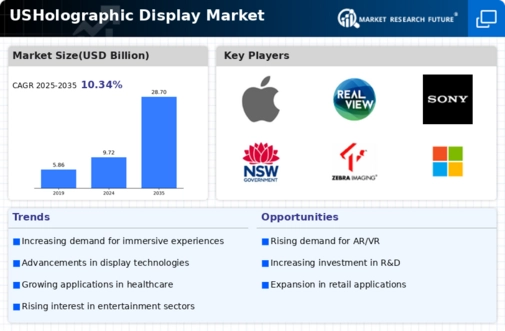The competition within the US Holographic Display Market is characterized by rapid advancements in technology and an increasing demand for immersive visual experiences across various sectors. Companies are keen to harness cutting-edge innovations to gain a competitive edge, leading to an evolving landscape where new entrants, established players, and tech start-ups are continuously in the race to redefine holographic display solutions. Factors such as enhanced product offerings, differentiation strategies, and growing consumer awareness about the potential applications of holographic displays play a significant role in shaping the competitive environment.
As the market expands, businesses are also focusing on collaborations and strategic partnerships to leverage complementary capabilities and tap into broader target audiences. Apple is a prominent player in the US Holographic Display Market, drawing on its reputation for innovation and excellence in technology. The company benefits from strong brand loyalty and a devoted customer base, mainly owing to its diverse ecosystem of products and services. Apple’s strength lies in its research and development capabilities, which enable the continual enhancement of its holographic and augmented reality applications.
The company’s robust distribution channels, including both online platforms and physical retail presence, further support its market penetration. Additionally, Apple’s commitment to user experience and design aesthetics positions it uniquely within the competitive landscape, contributing to its formidable presence and ongoing success in the sector focused on creating an immersive user experience through holographic displays.RealView Imaging operates within the US Holographic Display Market with a specific focus on advanced medical imaging technologies that leverage holographic display capabilities to enhance surgical procedures and medical training.
The company's key products include state-of-the-art holographic imaging software and solutions that provide surgeons with unparalleled visualization of anatomical structures. RealView Imaging distinguishes itself through strategic partnerships with healthcare institutions and universities, aiding in the development and testing of its groundbreaking technologies. The company actively explores mergers and acquisitions to accelerate its growth and expand its market reach while displaying significant strengths in innovation and product development. With an emphasis on real-time holographic imaging applications, RealView Imaging continuously seeks to push the boundaries of medical visualization, ensuring it remains a key competitor in the evolving US holographic display landscape.























Leave a Comment